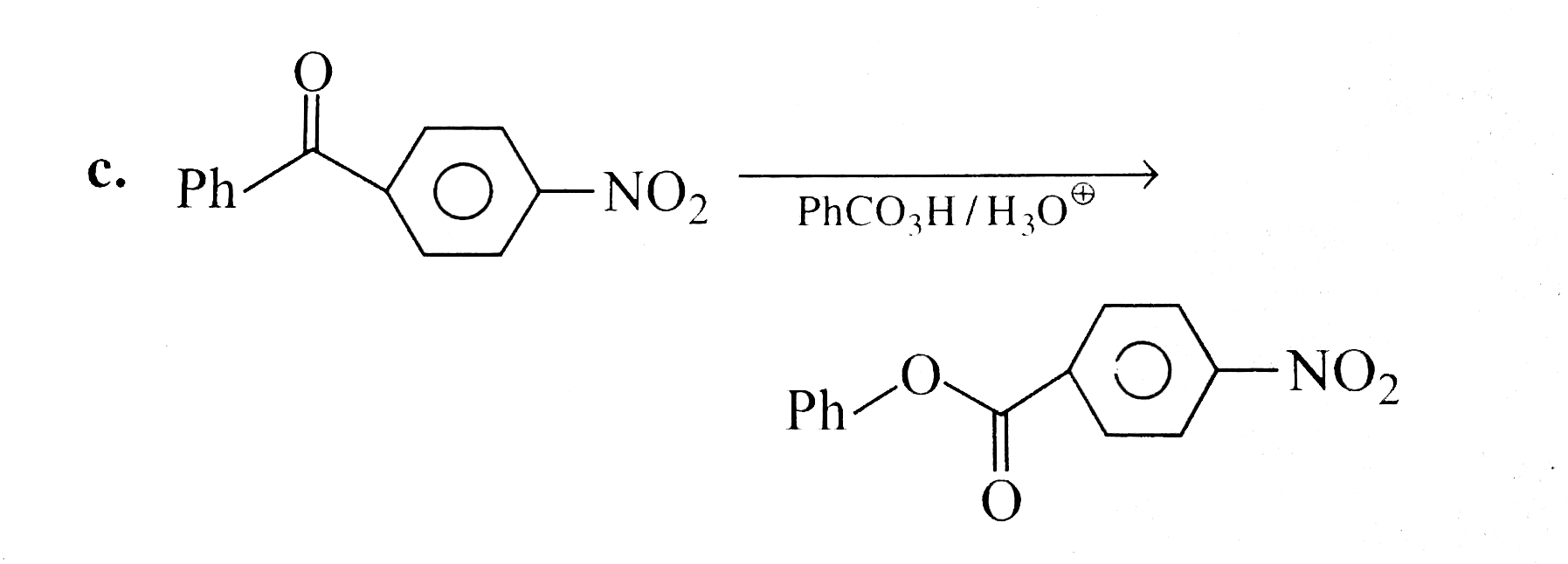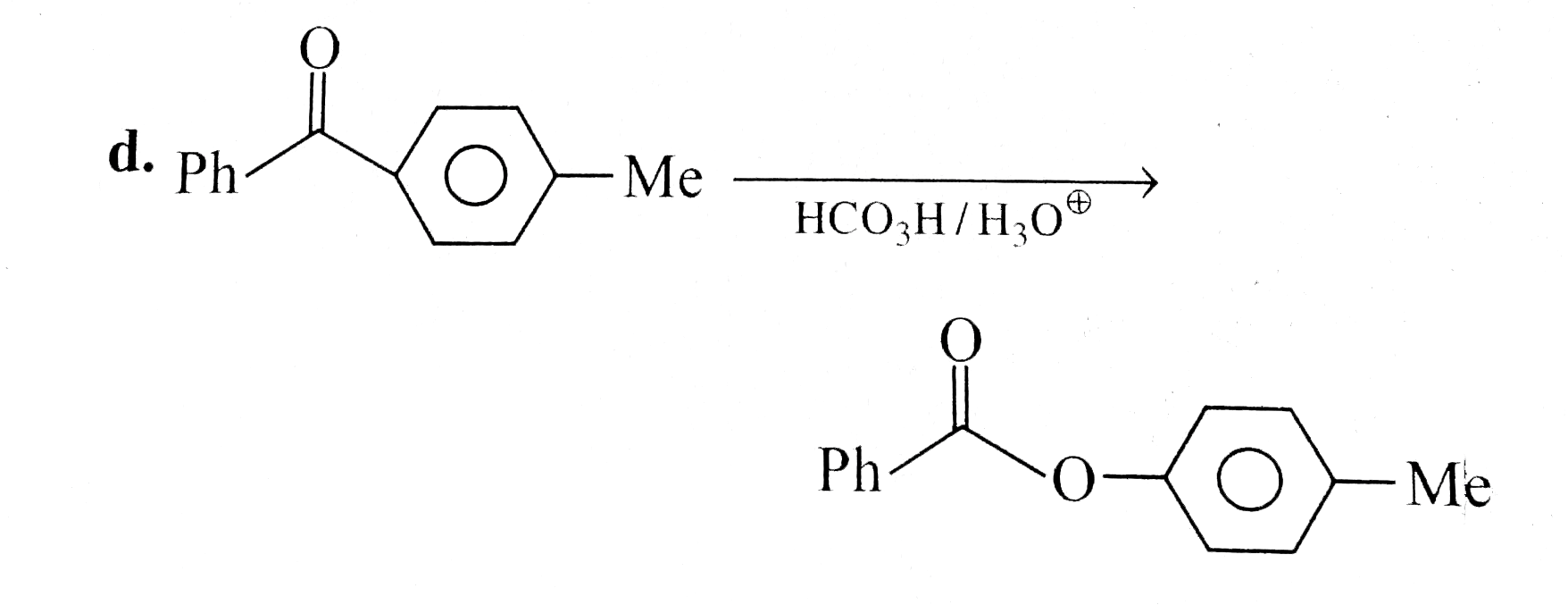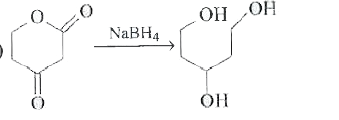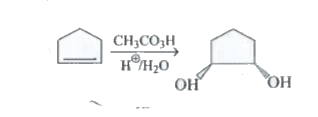Which of the following reaction is/are correct?
a.
b.
c.
d.
The correct Answer is:A, B, C, D
To determine which of the reactions are correct, we will analyze each reaction step by step based on the information provided in the video transcript.
Step 1: Identify the Reactions
The question presents multiple reactions, and we need to evaluate each one. The first two reactions involve the same reagents, which are Raney nickel and hydrogen.
Step 2: Analyze the First Two Reactions
- Reagents Used: Raney nickel and hydrogen.
- Type of Reaction: This is a reduction reaction.
- Mechanism: The carbonyl group (C=O) in the ketone (pentanone) is reduced to a CH2 group, forming a hydrocarbon (cyclopentane).
- Conclusion: The first reaction is correct.
Step 3: Analyze the Second Reaction
- Reagents Used: Same as the first reaction (Raney nickel and hydrogen).
- Substrate: Benzaldehyde (C6H5CHO).
- Mechanism: The carbonyl group in benzaldehyde is reduced to a CH2 group, forming toluene (C6H5CH3).
- Conclusion: The second reaction is also correct.
Step 4: Analyze the Third Reaction
- Reagents Used: Peroxo acid (peracid).
- Substrate: Ketone (R-C(=O)-R').
- Mechanism: The reaction with peroxo acid leads to the formation of an ester. The oxygen from the peracid is added to the more electron-rich alkyl group.
- Conclusion: The third reaction is correct.
Step 5: Analyze the Fourth Reaction
- Reagents Used: Peroxo acid (peracid).
- Substrate: Toluene (C6H5CH3) and phenyl ring (C6H5).
- Mechanism: The reaction with peracid will add oxygen to the more electron-rich group, which in this case is toluene due to the +I effect of the methyl group. Hence, oxygen will be added to the toluene side.
- Conclusion: The fourth reaction is also correct.
Final Conclusion
After analyzing all the reactions:
- Option A: Correct
- Option B: Correct
- Option C: Correct
- Option D: Correct
Thus, all of the reactions presented in the question are correct.
---
The question presents multiple reactions, and we need to evaluate each one. The first two reactions involve the same reagents, which are Raney nickel and hydrogen.
- Reagents Used: Raney nickel and hydrogen.
- Type of Reaction: This is a reduction reaction.
- Mechanism: The carbonyl group (C=O) in the ketone (pentanone) is reduced to a CH2 group, forming a hydrocarbon (cyclopentane).
- Conclusion: The first reaction is correct.
- Reagents Used: Same as the first reaction (Raney nickel and hydrogen).
- Substrate: Benzaldehyde (C6H5CHO).
- Mechanism: The carbonyl group in benzaldehyde is reduced to a CH2 group, forming toluene (C6H5CH3).
- Conclusion: The second reaction is also correct.
- Reagents Used: Peroxo acid (peracid).
- Substrate: Ketone (R-C(=O)-R').
- Mechanism: The reaction with peroxo acid leads to the formation of an ester. The oxygen from the peracid is added to the more electron-rich alkyl group.
- Conclusion: The third reaction is correct.
- Reagents Used: Peroxo acid (peracid).
- Substrate: Toluene (C6H5CH3) and phenyl ring (C6H5).
- Mechanism: The reaction with peracid will add oxygen to the more electron-rich group, which in this case is toluene due to the +I effect of the methyl group. Hence, oxygen will be added to the toluene side.
- Conclusion: The fourth reaction is also correct.
After analyzing all the reactions:
- Option A: Correct
- Option B: Correct
- Option C: Correct
- Option D: Correct
Topper's Solved these Questions
- REDUCTION AND OXIDATION REACTION OF ORGANIC COMPOUNDSBOOK - CENGAGE CHEMISTRY ENGLISHCHAPTER - REDUCTION AND OXIDATION REACTION OF ORGANIC COMPOUNDSEXERCISE - Exercise (Single Correct)
90 Videos
- REDUCTION AND OXIDATION REACTION OF ORGANIC COMPOUNDSBOOK - CENGAGE CHEMISTRY ENGLISHCHAPTER - REDUCTION AND OXIDATION REACTION OF ORGANIC COMPOUNDSEXERCISE - Exercise (Assertion And Reasoning)
10 Videos
- REDUCTION AND OXIDATION REACTION OF ORGANIC COMPOUNDSBOOK - CENGAGE CHEMISTRY ENGLISHCHAPTER - REDUCTION AND OXIDATION REACTION OF ORGANIC COMPOUNDSEXERCISE - Exercise (Linked Comprehension)
52 Videos
- QUALITATIVE INORGANIC SALT ANALYSISBOOK - CENGAGE CHEMISTRY ENGLISHCHAPTER - QUALITATIVE INORGANIC SALT ANALYSISEXERCISE - Viva Voce Questions And Part-C (Analysis Of Cations)
42 Videos
- SOLID STATEBOOK - CENGAGE CHEMISTRY ENGLISHCHAPTER - SOLID STATEEXERCISE - Ex 1.2 (Objective)
9 Videos
Similar Questions
Knowledge Check
Which of the following reactions are correct ?
A B
B C
C DCH3−C≡NLiAlH4−−−→CH3CH2NH2
DCH3−C≡NLiAlH4−−−→CH3CH2NH2Which of the following reactions are correct?
A B
B C
C D
D
Which of the following reactions are correct?
A B
B CCH3−O∣∣C−ClPhMgBr−−−−−→H⊕/H2OCH3−O∣∣C−PhDPhMgBrCO2−−−−−→H⊕/H2OPh−O∣∣C−OH
CCH3−O∣∣C−ClPhMgBr−−−−−→H⊕/H2OCH3−O∣∣C−PhDPhMgBrCO2−−−−−→H⊕/H2OPh−O∣∣C−OH
In following symbols are having usual meaning then which of the following reaction is correct ?
View SolutionWhich of the following reactions is correct?
View SolutionWhich of the following reactions is correct.
View SolutionWhich of the following reaction is correct :
View SolutionWhich of the following reactions is not correct ?
View Solution
